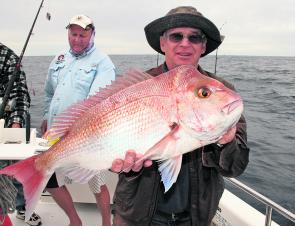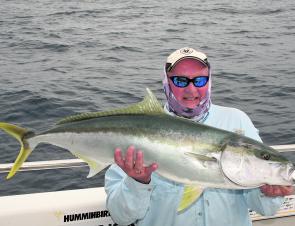This month is usually when the snapper action starts to heat up off the Tweed Coast.
The water is just about as cold as it is going to get and the fish have usually set in.
The inshore grounds can produce some really exceptional fish for those willing to put in the time and effort.
Although many of the inshore reefs off the Tweed do cop a fair hammering, they still continue to produce for those who are a bit more switched on to the slight changes. Things like baitfish, water clarity and time of day all influence just how and where these better-sized fish tend to bite.
The first hour of daylight is always going to be the best time to catch snapper but keep a watchful eye on the water colour. If it dirties up, you can expect the bite to last a fair bit longer.
The change of tide can also bring on a frantic bite period and if you can tie this in around daybreak or sunset, then it is really prime time.
Don’t get fixated on a certain technique. In cleaner water the plastics can often outfish bait, but when the water really dirties up, it can be hard to get a bite on plastics while the bait fishers are having a field day.
Keep your eyes open and be willing to change and you should enjoy consistent catches.
The wider grounds should also be fishing well, with a variety of bottom-dwellers on the cards. Pearl perch, snapper, teraglin, rosy jobfish and pigfish will be around in reasonable numbers.
Standard bottom-fish rigs like the two-hook paternoster will get you in on the action with the medium-sized fish, while the larger snapper generally come on floaters.
Don’t be shy to drop a floater in deep water; we have been catching some good-sized snapper in 90m-plus aboard RU4REEL.
The odd yellowfin tuna will also happily scoff a lightly weighted pilchard on the wider grounds; double the reason to try a floater.
The Tweed River has been fishing well in recent weeks and hopefully this will continue.
The odd mulloway has been making an appearance among the flathead, tailor and bream.
These fish generally inhabit similar areas to the bream and tailor and they often prey on them.
If you ensure that your light tackle is up to scratch and you are using a reasonable quality leader and line joined by good knots, then you can quite often land these great fish.
On one session on the Tweed we had a good run and caught three jewies while targeting bream off a rock wall. All fish were caught on 3” minnows rigged on 1/8oz TT jig heads using 3lb Toray Upgrade leader.
This is my standard deep-water bream set up and it handled the young jewies no worries.
When you do hook a good fish on light gear, try to get on top of it with the boat. This will lessen the chances of the fish rubbing you off on some underwater obstacle.
Take your time and use a reasonably high rod angle, which will cushion the effects that the fish’s mouth and body place on your leader and hook, especially those head shakes.
Take your time with the fish and let it play itself out. The worst thing that you can possibly do is to try to bully the fish with light line – it will only end in tears.
The usual bread-and-butter species like tailor, flathead, luderick and bream should be around in good numbers so get out there and enjoy some of the good Winter fishing that the Tweed has to offer.
Reads: 1407
This mulloway was a pleasant surprise for the author on light bream gear. Get over the top of the fish and don’t bully it, and the odds can turn in your favour.

It pays to be versatile when chasing quality snapper. This fish taken on board RU4REEL wanted a lightly weighted pilchard.

There should still be hungry kingies out wider. This one took a live bait on the 50-fathom line.




